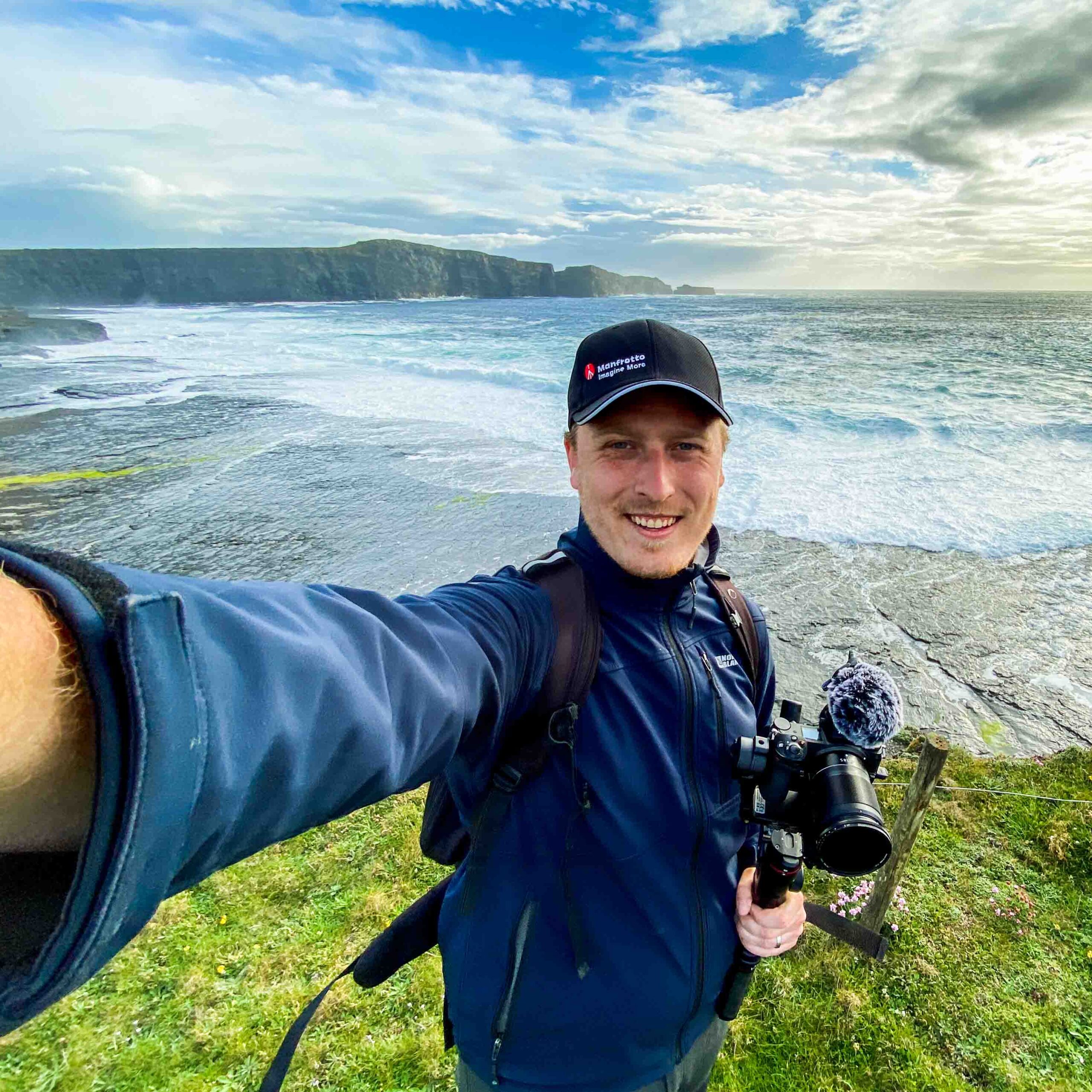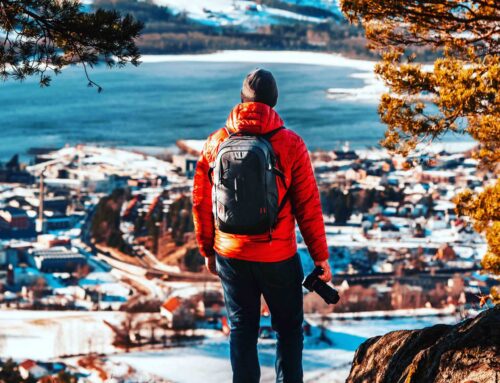Experience with the Manfrotto MVG220 Gimbal
This text is about my subjective impression of using gimbal Manfrotto MVG220. It is a test conducted during a rainy spring weather while shooting a two weeks during documentary film called „Malinká“ (Means:The Little One | Premiere date: late 2022). I tested this gimbal on the west coast of Ireland in May 2021.
The beginning of the story
During our recent work on another project with Petr Jan Juračka in the center of Brno, I met Jakub Stejskal, the founder of Stedis s.r.o (stedis.cz). The official distributor of Manfrotto in the Czechia and Slovakia. During breaks, we discussed the latest developments in the world of photo and video technology. Our conversation continued during a shared dinner as well. We also heard stories from traveler Hynek Adámek about his expedition to Africa, while Petr Jan Juračka shared his recent experiences from an erupting Iceland.
On the contrary, I was excited about the upcoming journey with Petr and Magda Fukanová (Czech Vibes). In two days from now, we are supposed to be in Dublin. From there we will travel by camper van to the western of the Atlantic coast. Magda is also the videographer of our three-member team. We are collectively shooting the documentary movie, and she will be editing the entire film.
Before midnight, Jakub discreetly brought a suitcase with the Manfrotto logo. Honestly, until that moment, I had no idea that this company also had gimbals in its arsenal. After a few sentences, I carefully placed the Manfrotto MVG220 gimbal in the car, with Jakub’s only condition being, „Don’t destroy it completely.“
Packing for the adventure
As a true guy, I pack for trips at the last possible moment. The same was true for Ireland, and I was still packing my things just before heading to the airport. Gimbal is delivered in a foam case that provides excellent protection during transport. However, it didn’t fit in my bag.We spend fourteen days in extreme conditions, I need more than just swimwear and two T-shirts. Moreover, this gimbal has a built-in battery (with a battery life of up to 7 hours), so according to the transportation rules, it had to go in my carry-on bag. I felt a bit anxious. I had already done this to my gimbal from another brand once. Back then, the click-through joystick got damaged in the bag, and I carried the entire gimbal unnecessarily. Additionally, the repair cost me almost half the price of that gimbal for a complete replacement of the motherboard.
Note: Consider the following lines as a story of what this three-axis stabilizer experienced with me, what it survived, and why it has a place in my camera bag.
About Manfrotto Gimbal
Manfrotto does not use a click-through joystick. Thanks to the locking mechanisms on all the stabilizer’s arms, it not only transports well but also balances easily. During balancing, you can unlock individual axes as needed, which speeds up the entire setup. The gimbal comes with a small but stable tripod which helps with balancing. That can be attached to the bottom and also extends the grip. It’s worth mentioning that the camera is attached using a quick-release plate with an ArcaSwiss standard. This feature makes my work during filming much easier because the quick-release plates are compatible with Manfrotto tripods.
Gimbal MVG220 has the rear motor positioned slightly lower, allowing for excellent visibility on the display. It’s eliminating the need for an external monitor as well. The entire setup can be much lighter, and the user will get tired more slowly. The touch screen allows for easy mode changes and camera calibration based on the specific lens weight. This eliminates the needs for using a separate app on the phone. Connected camera via a cable to directly directly exposure, white balance, and ISO values on the screen.
Payload capacity of Manfrotto MVG220 gimbal is 2.2 kg. I had no problem working with standard lenses like 20mm, 35mm, and 85mm. However, I couldn’t balance the Nikon Z7II with a 50mm f/1.2 lens and a small shotgun microphone. This combination is at the limit of the payload capacity. I would recommend the Manfrotto MVG460 model instead.
Keel Beach
It’s a beautiful sunny day. The clouds are just right, allowing the afternoon light to beautifully illuminate the cliffs rising from the ocean. I’m standing on a sandy Keel beach, filming slow-motion shots of incoming waves, with the water reaching up to my knees. Suddenly, this idyllic scene is unexpectedly interrupted by a slightly larger wave, and I find myself submerged in water up to my waist, with the gimbal half-soaked in the rubberized grip. Luckily, the entire grip of the stabilizer is made from a single piece, so water doesn’t have anywhere to seep in this part. Just to be safe, I quickly retreat to the shore and wipe off all the moisture, as I already have the shots I came for.
Riley’s tidal waves
I had a similar experience during the filming of the massive Riley’s tidal waves. Our host, George Karbus, took us to witness these waves during our expedition to Ireland. I was using the included extension handle. That handle works great when I need shots closer to the ground or when I want to hold the gimbal with both hands. At the end of the handle, there’s a convenient 1/4″ thread for accessories. Most frequently, it was used to attach a phone or a 360-degree camera for behind-the-scenes footage. But back to the observations from the story.
I had my back turned to the ocean, filming George, who was about 15 meters away from the crashing waves, capturing photos. Suddenly, he turned around, started sprinting away, and shouted at me to disappear. I didn’t even look back. I started running because when someone like George Karbus runs away from the ocean, and not towards it, it means trouble. In those few seconds of escape, one thought raced through my mind: „Hurry on those slippery rocks as far as possible, and if you fall, keep your hand with the gimbal as high as you can.“ George had a lead of no more than two seconds and he managed to reach a higher part of the cliff. I didn’t make it in time, protecting the stabilizer with my own body, even when the tidal wave soaked me. Fortunately, the water didn’t completely engulf me, and I didn’t slip.
Gimbal in salty brine
As we ran away from the giant waves, it started pouring rain relentlessly. „Why the hell is this water salty?“ Magda exclaimed next to me. There was nothing we could do; our backpacks were full of lenses and other cameras. I threw a cloth over the setup for wiping the optics and we embarked on a half-hour journey back to the car. At that moment, I even forgot about the involuntary swimming. I was wearing several layers of outdoor clothing but I was soaked to the bone anyway. I prayed lately in the car that this wouldn’t be gimbal’s last filming experience. And since it continued to function without any issues, I had no problem filming for the rest of our adventure in any weather.
Summarization
In the end, we got soaked every day during the expedition, but the weather compensated us with beautiful sunrises and sunsets, as well as sunny weather during several snorkeling sessions with a three-meter dolphin living along the coast. Our three-member team ended up taking home around 21,000 videos and photos, which will mostly be used to create time-lapses. Just to give you an idea, that’s about 3 TB of material. We used five cameras, three drones, and two action cameras to capture the data.
Of course, I’ve had many nice and safe days with the Manfrotto MVG220 gimbal as well, but that goes without saying. I would recommend this stabilizer to anyone shooting in any weather conditions or on long trips without electricity. I only needed to charge the battery three times in two weeks. I always recharged it when it reached around 20% because you never know how long you’ll need to film. I charged it using a power bank or the 12V socket in the car, thanks to the USB-C standard. The only potential downside may be the inability to disassemble the gimbal and make it even more compact. That’s something everyone has to judge for themselves.
I would love to try out other compatible accessories as well, especially the Fast Gimboom Carbon extension pole. That allows you to safely extend the gimbal handle by up to 115 cm, enabling filming from a high overhead perspective or simulating a camera crane. After fourteen days of working with this, in my opinion, perfect stabilizer, I can only thank Jakub Stejskal for the opportunity to test this likable assistant in the rugged conditions of western Ireland.




Napsat komentář